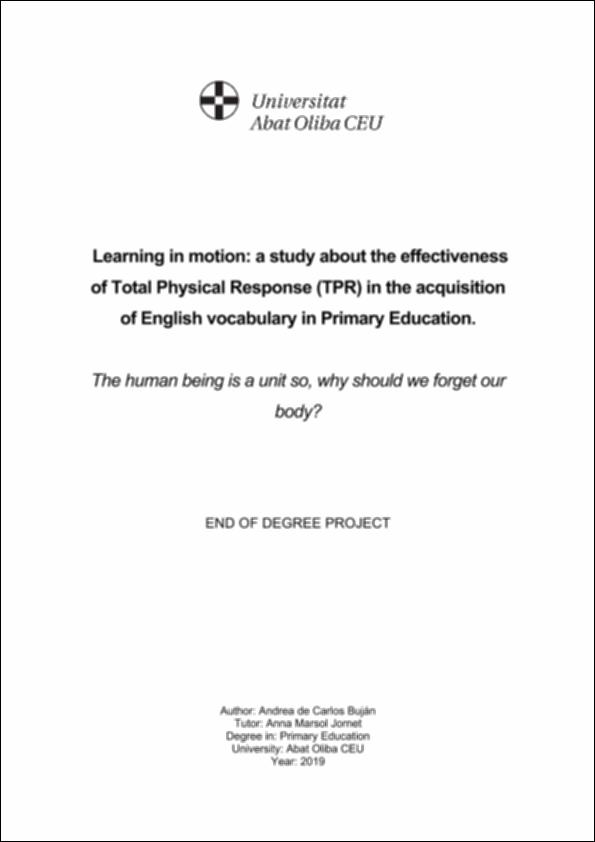Please use this identifier to cite or link to this item:
http://hdl.handle.net/10637/11503Learning in motion a study about the effectiveness of Total Physical Response (TPR) in the acquisition of English vocabulary in Primary Education
| Title: | Learning in motion a study about the effectiveness of Total Physical Response (TPR) in the acquisition of English vocabulary in Primary Education |
| Authors : | Carlos-Buján, Andrea de |
| Abstract: | El treball exposat en les següents pàgines recull els fonaments i conceptes clau de
“Total Physical Response (TPR)”, una eina d'ensenyament d'una segona llengua
desenvolupada per James J. Asher durant la segona meitat del segle XX. Un dels
propòsits d'aquesta recerca és la presentació sistematitzada d'un recull i revisió
bibliogràfica de la tècnica “Total Physical Response (TPR)” per aprendre una llengua
estrangera a través d'accions, per tal de conèixer les seves característiques i
principis bàsics i la seva correcta aplicació. Aquest document també revisa la
investigació realitzada sobre els beneficis d'utilitzar el cos i el moviment físic en
l'aprenentatge. A més, proporciona un marc teòric de l'adquisició d'una segona
llengua (ASL). Les idees principals de la proposta d'Asher són que una segona
llengua es pot aprendre millor mitjançant l'ús de converses entre cos i llengua i
creant condicions similars a l'adquisició de la primera llengua. L'autor considera que
el TPR ofereix un alt potencial per desenvolupar habilitats lingüístiques en una
atmosfera lliure d'estrès i en contextos comunicatius significatius en els quals els
estudiants tenen una comprensió instantània dels missatges verbals que emet
l'instructor i en els quals poden ser físicament actius. L'objectiu central del treball és
dur a terme una investigació empírica per examinar si el TPR és més efectiu que un
enfocament basat en la traducció en l'adquisició de vocabulari en anglès en
l'Educació Primària. Tot i les limitacions, els resultats indiquen que l'enfocament de
TPR és més efectiu que un enfocament basat en la traducció per ensenyar nou
vocabulari a nens. El trabajo expuesto en las siguientes páginas recoge los fundamentos y conceptos clave de “Total Physical Response (TPR)”, un enfoque de enseñanza de una segunda lengua desarrollado por James J. Asher durante la segunda mitad del siglo XX. Uno de los propósitos de esta investigación es la presentación sistematizada de una recopilación y revisión bibliográfica de la técnica “Total Physical Response (TPR)” para aprender una lengua extranjera a través de acciones, con el fin de conocer sus características y principios básicos y su correcta aplicación. Este documento también revisa la investigación realizada sobre los beneficios de usar el cuerpo y el movimiento físico en el aprendizaje. Además, proporciona un marco teórico sobre la adquisición de una segunda lengua (ASL). Las ideas principales de la propuesta de Asher son que una segunda lengua puede aprenderse mejor mediante el uso de conversaciones entre cuerpo y lengua y creando condiciones similares a la adquisición de la primera lengua. El autor considera que TPR ofrece un alto potencial para desarrollar habilidades lingüísticas en una atmósfera libre de 6 estrés y en contextos comunicativos significativos en los que los estudiantes tienen una comprensión instantánea de los mensajes verbales producidos por el instructor y en los que pueden ser físicamente activos. El objetivo central del trabajo es llevar a cabo una investigación empírica para examinar si TPR es más efectivo que un enfoque basado en la traducción en la adquisición de vocabulario en inglés en la Educación Primaria. A pesar de las limitaciones, los resultados indican que el enfoque de TPR es más efectivo que un enfoque basado en la traducción para enseñar nuevo vocabulario a niños. The project introduced in the following pages includes the fundamentals and key concepts of Total Physical Response (TPR), a second language teaching approach developed by James J. Asher throughout the second half of the 20th century. One of the purposes of this research is the systematized presentation of a compilation and bibliographic review of Total Physical Response (TPR) approach to learn a foreign language through actions in order to know its basic characteristics and principles and its correct application. This paper also reviews the research conducted on the benefits of using the body and physical movement in learning. Moreover, it provides a theoretical framework of Second Language Acquisition (SLA). The main ideas of Asher’s approach are that a second language can be best learnt by using languagebody conversations and by creating similar conditions to first language acquisition. The author considers that TPR offers a high potential to develop linguistic skills in a stress-free atmosphere and in meaningful communicative contexts in which students have instant understanding of the input produced by the instructor and in which they can be physically active. The central aim of the paper is to carry out an empirical investigation to examine if TPR is more effective than a Translation-based approach in the acquisition of English words in Primary Education. Notwithstanding the limitations, the results indicate that TPR approach is more effective than a Translation-based approach in teaching new vocabulary to children. |
| URI: | http://hdl.handle.net/10637/11503 |
| Rights : | L'accés als continguts d'aquest document queda condicionat a l'acceptació de les condicions d'ús establertes per la següent llicència Creative Commons:http://creativecommons.org/licenses/by-nc-nd/4.0/ |
| Issue Date: | Jun-2019 |
| Center : | Universitat Abat Oliba CEU |
| Appears in Collections: | TFG |
This item is licensed under a Creative Commons License



